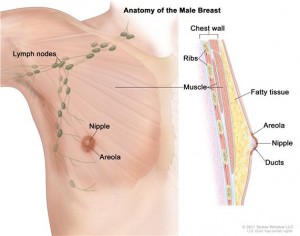
Breast Cancer Can Also Affect Men
-
Although we typically think of women when we think of breast cancer, approximately 2,000 men per year are diagnosed with the disease.

We know that male breast cancer seems to behave similarly to female breast cancer, but although the numbers are small, we treat the disease similarly. One difference between the two is in the timing of when men present with the disease, as versus when women seek care for the issue. This was the topic of a recent article in the Washington Post.
Women now typically undergo mammographic screening, bringing tumors that are not palpable to the attention of a doctor. Men do not undergo such screening because they usually have far less breast tissue and most tumors in the breast can be felt. Unfortunately however, while women are well aware that a breast lump is a concerning sign that should be brought to the attention of a doctor, many men still feel either embarrassed about seeking care for a breast lump, or are incredulous at the idea that they could have breast cancer or a serious illness that has become symptomatic. The consequence is that men tend to present to their doctors at a later stage, initially ignoring the finding more frequently than women do. When you compare the genders however, men do as well as women, stage for stage.
The typical treatment for men having breast cancer is a mastectomy, because there is little breast tissue to save, and resecting the tumor completely with “negative margins” (a margin of normal tissue surrounding the tumor, showing that it has been completely removed) may be more difficult. In women, the cosmetic and sexuality issues surrounding the breast prompted investigation of lumpectomy with radiation as an alternative to mastectomy, and has been found to be equally safe. In men this has not been investigated sufficiently in trials to date to conclude this is safe. Men therefore have mastectomies as standard surgical treatment, along with assessment of lymph nodes.
When a man develops a breast lump, it is consequently important that he seek evaluation by a physician. While most lumps tend to be benign, a breast surgeon is best qualified to determine if this is something that may be normal or should be further assessed to rule out breast cancer. Never ignore such a finding, and certainly don’t be embarrassed to seek care. Better to “overreact” and seek care for something that’s benign, than ignore the problem and find out too late that it could have more easily been addressed earlier.
